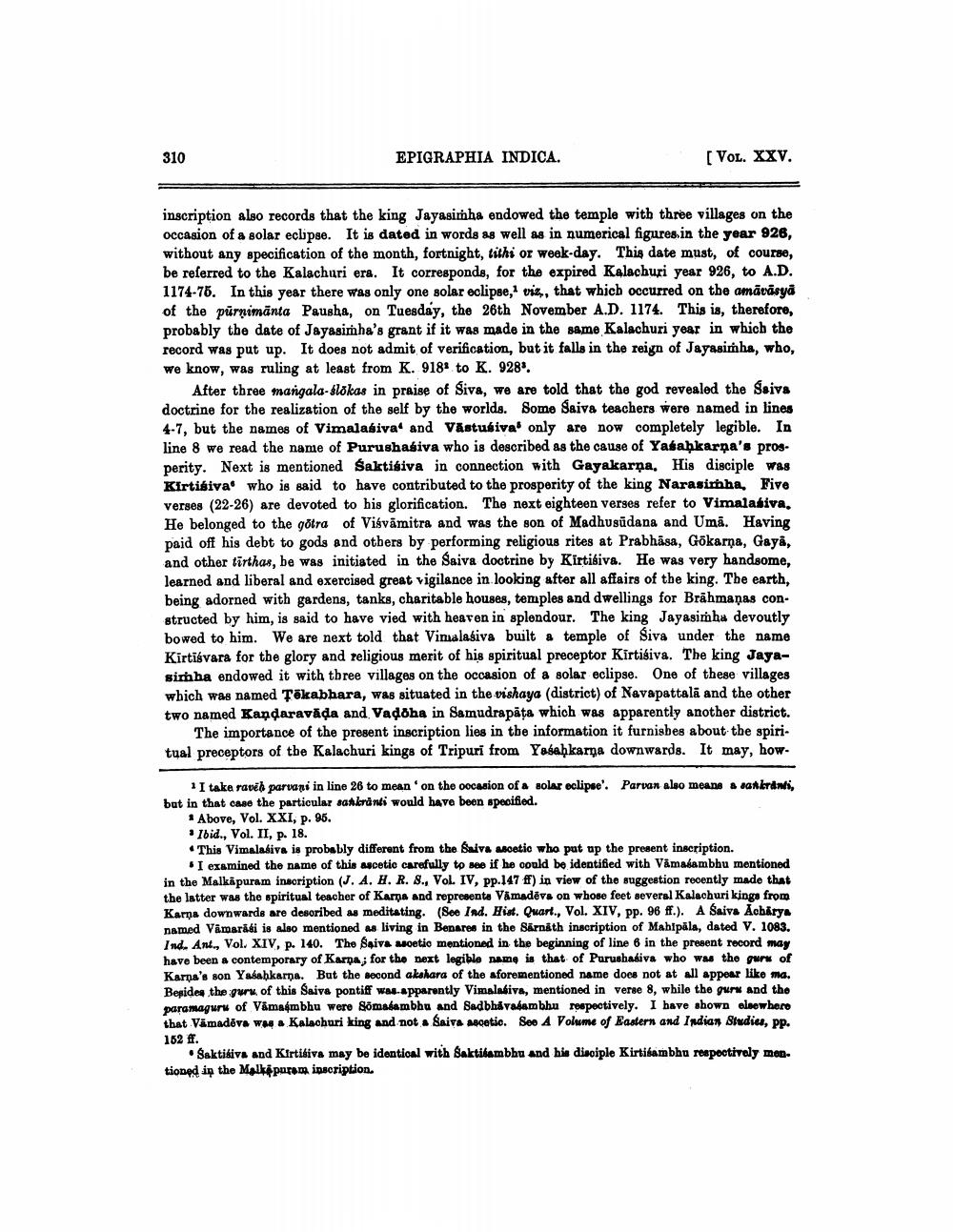________________
310
EPIGRAPHIA INDICA.
[VOL. XXV.
inscription also records that the king Jayasimha endowed the temple with three villages on the occasion of a solar eclipse. It is dated in words as well as in numerical figures in the year 926, without any specification of the month, fortnight, tithi or week-day. This date must, of course, be referred to the Kalachuri era. It corresponds, for the expired Kalachuri year 926, to A.D. 1174-75. In this year there was only one solar eclipse,1 viz,, that which occurred on the amavāsyā of the purnimanta Pausha, on Tuesday, the 26th November A.D. 1174. This is, therefore, probably the date of Jayasimha's grant if it was made in the same Kalachuri year in which the record was put up. It does not admit of verification, but it falls in the reign of Jayasimha, who, we know, was ruling at least from K. 918 to K. 928".
After three mangala-slokas in praise of Siva, we are told that the god revealed the Saiva doctrine for the realization of the self by the worlds. Some Saiva teachers were named in lines 4-7, but the names of Vimalasiva and Vastusivas only are now completely legible. In line 8 we read the name of Purushasiva who is described as the cause of Yasaḥkarna's prosperity. Next is mentioned Saktisiva in connection with Gayakarna. His disciple was Kirtisiva who is said to have contributed to the prosperity of the king Narasimha, Five verses (22-26) are devoted to his glorification. The next eighteen verses refer to Vimalasiva, He belonged to the götra of Visvamitra and was the son of Madhusudana and Uma. Having paid off his debt to gods and others by performing religious rites at Prabhāsa, Gōkarṇa, Gaya, and other tirthas, be was initiated in the Saiva doctrine by Kirtiśiva. He was very handsome, learned and liberal and exercised great vigilance in looking after all affairs of the king. The earth, being adorned with gardens, tanks, charitable houses, temples and dwellings for Brāhmaṇas constructed by him, is said to have vied with heaven in splendour. The king Jayasimha devoutly bowed to him. We are next told that Vimalasiva built a temple of Siva under the name Kirtisvara for the glory and religious merit of his spiritual preceptor Kirtiśiva. The king Jayasimha endowed it with three villages on the occasion of a solar eclipse. One of these villages which was named Tēkabhara, was situated in the vishaya (district) of Navapattala and the other two named Kandaravada and Vaḍöha in Samudrapata which was apparently another district.
The importance of the present inscription lies in the information it furnishes about the spiritual preceptors of the Kalachuri kings of Tripuri from Yasahkarna downwards. It may, how
1 I take raveh parvani in line 26 to mean 'on the occasion of a solar eclipse'. Parvan also means a sankranti, but in that case the particular sankranti would have been specified.
Above, Vol. XXI, p. 95.
Ibid., Vol. II, p. 18.
This Vimalasiva is probably different from the Saiva ascetic who put up the present inscription.
I examined the name of this ascetic carefully to see if he could be identified with Vamasambhu mentioned in the Malkapuram inscription (J. A. H. R. S., Vol. IV, pp.147 ff) in view of the suggestion recently made that the latter was the spiritual teacher of Karna and represents Vamadevs on whose feet several Kalachuri kings from Karna downwards are described as meditating. (See Ind. Hist. Quart., Vol. XIV, pp. 96 ff.). A Saiva Acharya named Vamarasi is also mentioned as living in Benares in the Sarnath inscription of Mahipala, dated V. 1083. Ind. Ant., Vol. XIV, p. 140. The Saiva ascetic mentioned in the beginning of line 6 in the present record may have been a contemporary of Karna; for the next legible name is that of Purushasiva who was the guru of Karpa's son Yasahkarna. But the second akshara of the aforementioned name does not at all appear like ma. Besides the guru of this Saiva pontiff was apparently Vimalasiva, mentioned in verse 8, while the guru and the paramaguru of Vamaémbhu were Sömasambhu and Sadbhavasambhu respectively. I have shown elsewhere that Vamadeva was a Kalachuri king and not a Saiva ascetic. See A Volume of Eastern and Indian Studies, pp. 152 ff.
• Šaktisiva and Kirtisiva may be identical with Saktisambhu and his disciple Kirtisambhu respectively men. tioned in the Malkapuram inscription.




